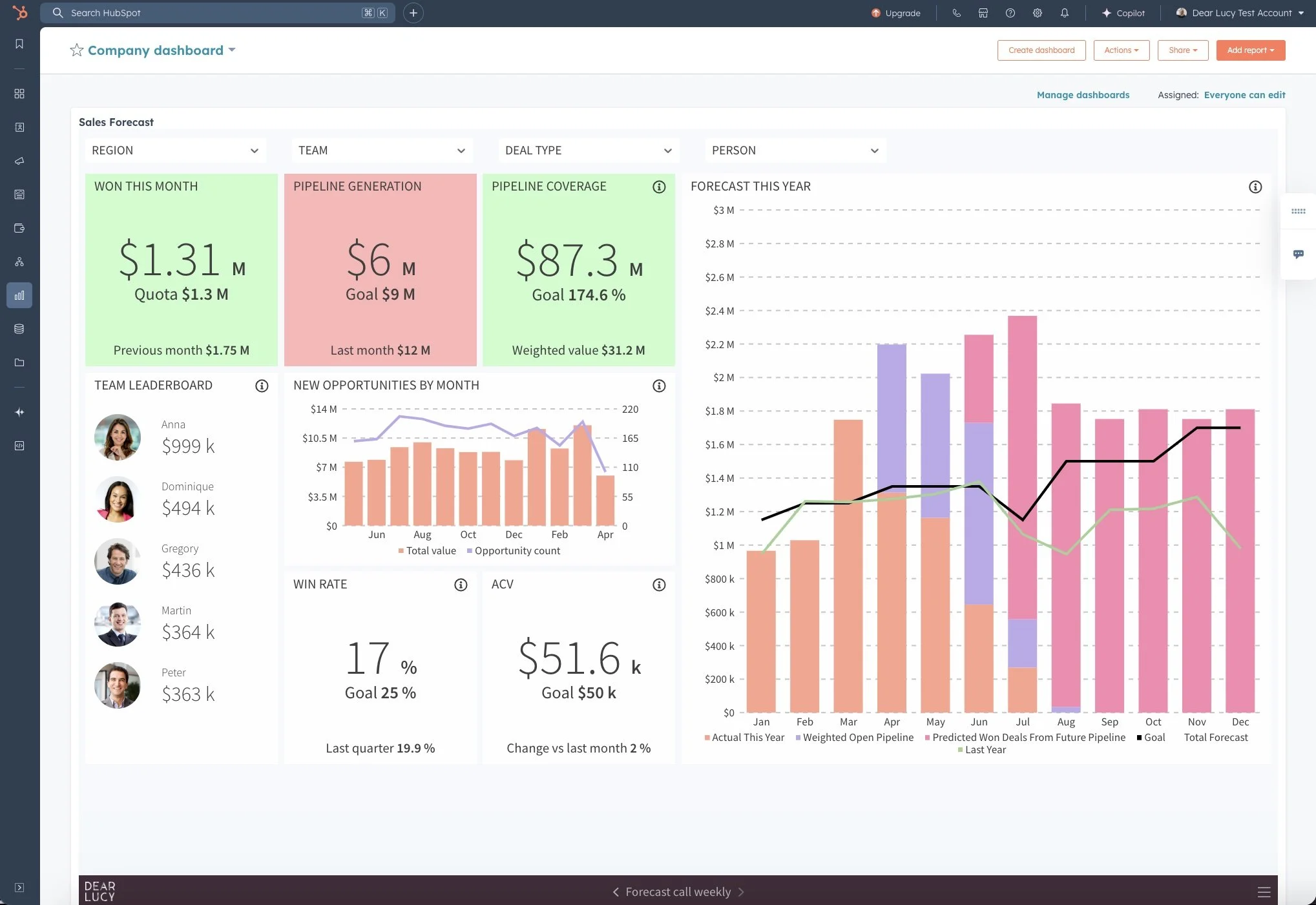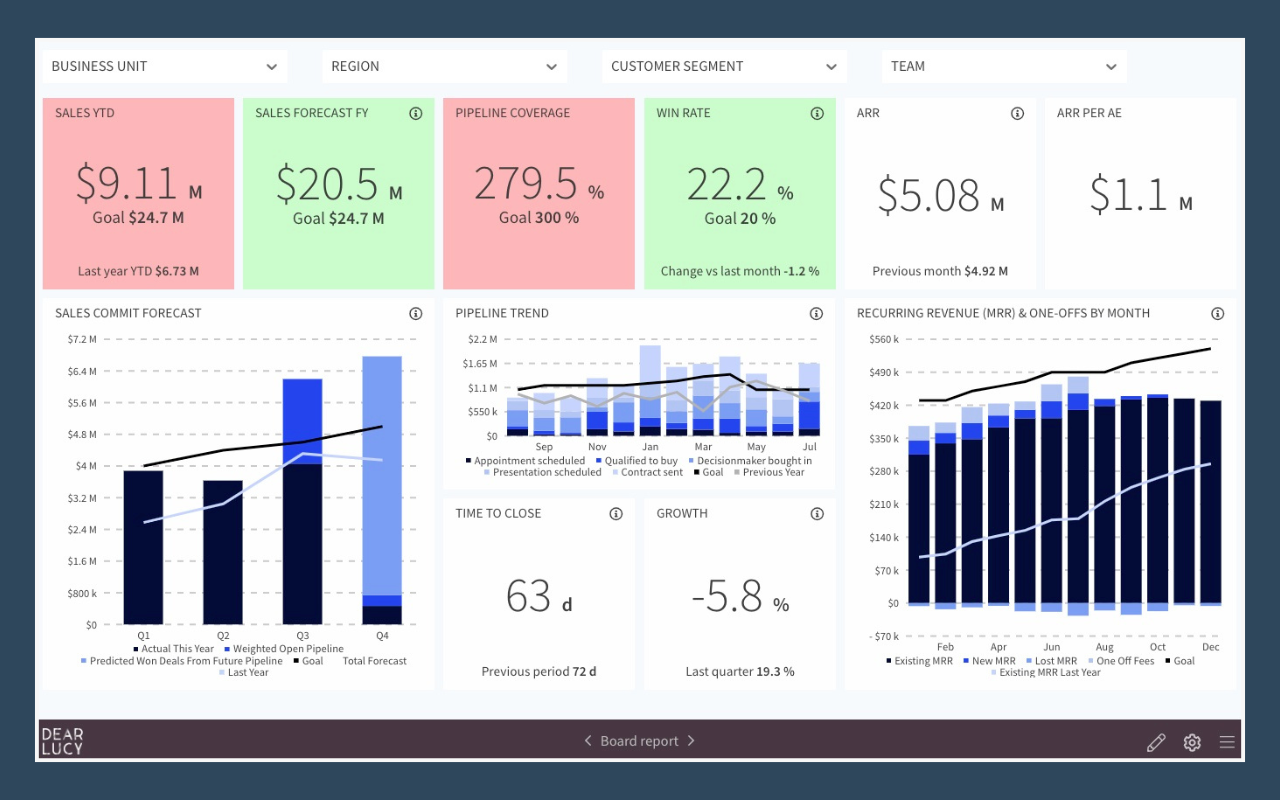Sales forecasting has always been a cornerstone of strategic planning. But the way leading B2B companies forecast today is changing fast.
Organizations no longer accept manual guesses or gut-feel rollups. They demand fast, accurate forecasts that power financial planning, sales coaching, and growth execution. Leaders want visibility, predictability, and the ability to steer outcomes before the quarter ends — not just explain them after.
This post shows how top-performing teams are shifting toward predictive, AI-powered HubSpot forecasting workflows — and how HubSpot users can get there with the right tools.
Forecasting Is No Longer About Guesswork
Forecasting is no longer a quarterly ritual. In high-performing B2B organizations, it's a weekly workflow. It ties directly into sales check-ins, pipeline reviews, and strategic decisions. And it's evolving across five clear trends.
Forecasts Are Now Iterative and Embedded
Top-performing teams treat forecasting as a dynamic, ongoing process. Rather than setting a number once and forgetting it, they revisit forecasts every week. These sessions fuel rep coaching, resource planning, and strategic adjustments — turning forecasts into an active driver of sales performance.
Today, forecasting isn’t just about asking “how much will we hit?” It’s a combination of financial modeling, pipeline analysis, and frontline execution planning — all working together to steer the business forward.
Predictive Inputs Are Replacing Gut Feel
Forecasting used to hinge on sales reps' instincts — a gut check on what might close and when. But that approach doesn’t scale, and it rarely holds up under scrutiny. Today’s best teams rely on data-backed signals. Algorithms now track how deals progress through the pipeline, detect meaningful activity, flag slipping close dates, and compare patterns to past performance. It’s no longer about who feels confident — it’s about what the data reveals is most likely to close.
One of the most powerful predictive inputs is deal scoring. HubSpot has a built-in model, but advanced teams take it further — see our deep dive in HubSpot Deal Score: From AI Predictions to Revenue Impact.
Forecast Accuracy Combines AI and Human Insight
The best forecasts aren’t driven by AI alone — or by gut instinct. High-performing teams blend algorithmic scoring with human judgment to get the best of both. AI highlights risk patterns and deal momentum, while reps validate what’s really happening on the ground. This hybrid forecasting model keeps predictions sharp and grounded in reality.
Multi-Scenario Models Are Becoming Standard
Modern sales leaders don’t plan around a single forecast. Instead, they map Commit, Best Case, and Upside scenarios — then adjust tactics to each. Some teams go even further, applying superforecasting principles where predictions evolve based on new inputs, feedback loops, and shifting deal dynamics across the pipeline. It’s a more resilient way to plan in uncertain conditions.
Forecast Quality Depends on CRM Hygiene
Even the most advanced forecasting model becomes unreliable if your CRM data is inconsistent. Deals with missing close dates, no recent activity, or flawed stage progression can significantly distort forecast quality. That’s why forward-thinking teams treat data hygiene as the foundation of reliability—using dashboards that automatically flag data issues before they become revenue risks.
5 Critical Capabilities Behind Accurate Sales Forecasts
Modern forecasting doesn’t just happen — it’s built on a foundation of core capabilities that set high-performing sales teams apart from those relying on intuition or spreadsheets.
1. Predictive Forecasting That Reacts to Reality
Your forecasts should evolve as your pipeline does. Instead of static, rep-submitted numbers, top teams rely on predictive forecasts powered by deal activity, pipeline movement, and stage progression. This shifts forecasting from opinion to evidence.
2. Forecast vs. Actual Feedback Loops
Accuracy requires accountability. By continuously comparing forecasts to real outcomes, high-growth teams refine their assumptions and improve performance over time. It’s how forecasting becomes a measurable, improvable process — not a guessing game.
3. Live Pacing and Coverage Monitoring
The best teams don’t wait for end-of-month surprises. They monitor pipeline coverage, deal velocity, and conversion rates in real time — with automated alerts when targets are at risk. This enables fast action while there’s still time to course-correct.
4. Multi-Scenario Planning
There’s never just one forecast. Elite revenue teams model multiple scenarios — Commit, Best Case, and Stretch — and link each to the specific deals and risks behind them. This enables better resource planning and more confident decision-making.
5. Built-In CRM Hygiene Checks
Bad data equals bad forecasts. That’s why modern forecasting tools highlight pipeline risks tied to hygiene — like missing close dates, inactive deals, or suspicious stage changes. It’s a built-in safeguard against forecast distortion.Forecasting in Practice: How Top Teams Use It
Measuring Forecast Accuracy in HubSpot
Forecasts only become valuable when you know how close they are to reality. That’s why high-performing sales teams track forecast accuracy as carefully as they track pipeline or quotas.
HubSpot natively offers basic forecast rollups, but it doesn’t provide deeper accuracy metrics like MAPE (Mean Absolute Percentage Error), weighted accuracy (WMAPE), or bias tracking. Without those, it’s hard to answer the board-level question every CRO hears:
“When we call a number, how close do we actually land?”
That’s where Dear Lucy adds a critical layer inside HubSpot:
Quarterly & monthly forecast accuracy % calculated automatically (MAPE).
Forecast vs. actual deviation in clear €/$ terms.
Rolling accuracy trends to show if predictions are improving over time.
Bias indicators that reveal whether teams are sandbagging or over-calling.
The result? You can measure forecast quality directly in HubSpot — no spreadsheets, no manual work. See the Forecast Accuracy Dashboard in action.
HubSpot Forecasting in Action: Real-World Use Cases for Revenue Teams
1. Sales Rep 1:1s – From Subjective to Objective
Reps review their pipelines using score-based dashboards that spotlight top deals, risk indicators, and next best actions. It’s not about how they feel — it’s about what the data shows.
2. Weekly Forecast Calls – Data-Driven, Not Gut-Driven
Sales leaders use predictive scores, pacing metrics, and forecast vs. actual insights to validate rep inputs. Assumptions are challenged early — before surprises happen.
No spreadsheets. No guesswork. Just live forecasts synced from HubSpot.
3. Board & Exec-Level Reporting – Ready When It Matters
CROs and CEOs access high-level dashboards showing commit vs. upside, pacing against targets, and segment-level risk — without needing to log into HubSpot.
The result? Faster prep, more confident decisions, and fewer last-minute fire drills before board meetings.
Want to see how your forecasts connect to reports?
Check out The Complete Guide to HubSpot Reporting for examples of sales dashboards that visualize pipeline, goals, and rep performance.
What HubSpot Forecasting Offers Natively
HubSpot forecasting is great for pipeline visibility and basic quota tracking. It’s simple, visual, and easy to adopt — especially for smaller or early-stage sales teams.
What you get:
Rep-submitted forecasts with manual updates
Forecast categories like Pipeline, Commit, and Best Case
Quota rollups and team-level views
A built-in deal scoring model (not customizable)
Strengths:
Easy to set up
Well suited to early-stage forecasting
Seamless pipeline visibility
Limitations for more advanced needs:
No predictive forecasting
No deal scoring customization by team, region, or business type
No multi-scenario modeling
No forecast vs. actual analytics
No pacing alerts or pipeline risk insights
Start Predictive Forecasting in HubSpot with Dear Lucy
Most sales teams outgrow manual rollups and static pipeline snapshots. With Dear Lucy, you don’t need to leave HubSpot — you just need a smarter forecasting layer on top.
Dear Lucy turns your HubSpot CRM into a predictive forecasting engine with real-time updates, customizable deal scoring, and visual dashboards that align reps, managers, and leadership.
Here’s what you get:
Predictive forecasts by rep, team, business unit, or company
Customizable deal scoring (1–99% close probability) — tailor models by business type (e.g., new vs. existing)
Visual dashboards embedded inside HubSpot — and shareable with execs or board (no login needed)
Live forecast updates as CRM data changes — no spreadsheet work
Goal tracking and pacing alerts to stay on target
Go live in minutes. Forecast with confidence.
Final Thoughts
Forecasting isn’t just about hitting a number — it’s about running your business with clarity and control.
If you’re using HubSpot but still relying on spreadsheets, static rep inputs, or gut-feel forecasts, there’s a better way.
Dear Lucy turns your CRM into a real-time forecasting engine — without adding new tools, admin, or complexity.
TL;DR — What You’ll Learn in This Blog
Forecasting is no longer about guesswork — it’s a strategic, data-driven workflow
Top teams combine AI models, CRM hygiene, and real-time pacing to improve accuracy
HubSpot forecasting works for visibility and quota rollups — but lacks predictive depth
Dear Lucy brings predictive forecasting, customizable deal scoring, and board-ready dashboards into your HubSpot CRM
You can get started with zero setup — and see your first forecast in minutes
FAQ: HubSpot Forecasting & Dear Lucy
Does HubSpot have forecasting built in?
Yes. HubSpot offers basic forecasting tools based on pipeline categories, rep submissions, and quotas. But it lacks predictive scoring, multi-scenario planning, and real-time pacing.
What is predictive forecasting?
It uses real-time deal activity, historical data, and pipeline patterns to automatically generate revenue forecasts — no manual inputs needed.
How is Dear Lucy different from HubSpot’s forecasting?
Dear Lucy adds predictive models, customizable deal scoring, forecast vs. actual analytics, and pacing alerts — all embedded in HubSpot.
How long does it take to set up?
You can start in minutes via OAuth — no coding, spreadsheets, or integrations needed.
About Dear Lucy
Dear Lucy is the forecasting and sales performance engine for HubSpot teams.
We help high-performing revenue teams:
Build predictive forecasts
Track layered sales goals in real time
Fix CRM data hygiene at the source
Align reps, managers, and leadership around one set of numbers
Seamlessly embedded in HubSpot. Visual. Actionable. Fast.
Want the full picture of what Dear Lucy can do in HubSpot?
→ Explore Dear Lucy for HubSpot — predictive forecasting, dashboards, goal tracking & more, embedded right into your CRM.





